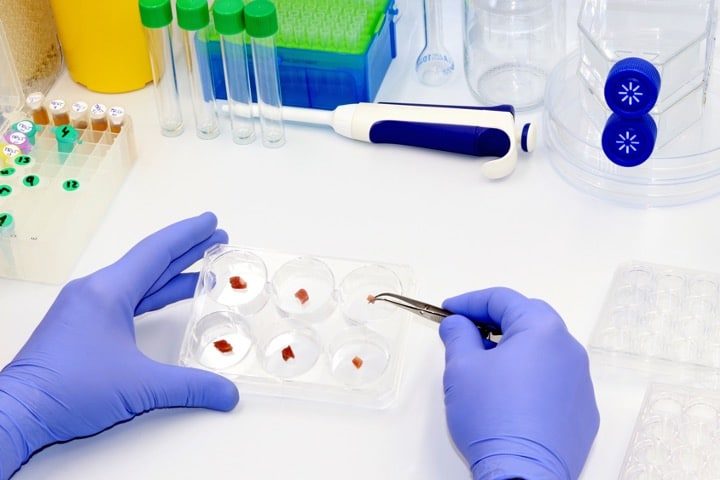
The lab-grown meat industry has gained a major victory.
On Wednesday, U.S. regulators greenlighted the sale of chicken cultivated in labs using animal cells, with these products set to soon appear in restaurants.
Upside Foods and Good Meats were the two firms to be cleared by the U.S. Department of Agriculture for sale of their “cell-cultivated meat.”
These companies assert that their meat eliminates the harming of animals while reducing the environmental effects of meat production, such as land use and animal waste.
Josh Tetrick, co-founder and chief executive of Eat Just, of which Good Meats is a subsidiary, told the Associated Press: “Instead of all of that land and all of that water that’s used to feed all of these animals that are slaughtered, we can do it in a different way.”
The lab-made meat will not be arriving in supermarkets in the immediate future. For the moment, cultivated chicken is pricier than regular chicken, and it cannot yet be produced on a mass scale. The two firms currently plan to make their chicken available to the public through partnerships with restaurants; Upside is working with a San Francisco restaurant called Bar Crenn, and Good Meat’s products will be prepared at a D.C.-based restaurant owned by chef Jose Andrés.
The Good Meat chicken will arrive at the restaurant precooked, needing only to be heated. AP, which looked at Upside’s chicken, reported that it “was slightly paler than the grocery store version,” but otherwise tasted like regular poultry.
AP described the process by which the meat is grown:
Cultivated meat begins with cells. Upside experts take cells from live animals, choosing those most likely to taste good and to reproduce quickly and consistently, forming high-quality meat, [Upside’s chief operating officer Amy] Chen said. Good Meat products are created from a master cell bank formed from a commercially available chicken cell line.
Once the cell lines are selected, they’re combined with a broth-like mixture that includes the amino acids, fatty acids, sugars, salts, vitamins and other elements cells need to grow. Inside the tanks, called cultivators, the cells grow, proliferating quickly. At Upside, muscle and connective tissue cells grow together, forming large sheets. After about three weeks, the sheets of poultry cells are removed from the tanks and formed into cutlets, sausages or other foods. Good Meat cells grow into large masses, which are shaped into a range of meat products.
AP teamed up with NORC Center for Public Affairs Research to conduct a poll to gauge Americans’ feelings about lab-grown meat. Half of adults in the country say they’re not likely to eat cultivated meat products. Most said they resist it because “it just sounds weird,” while some believe it isn’t safe.
Vast amounts of money have already been invested in the lab-grown meat processes that proponents claim is the future of food. The “Big Three” in the industry — Believer Meat, Eat Just, and Upside Foods — are collectively the recipients of $1.2 billion in venture funding to get their products ready to sell in stores.
These companies are also supported by globalist outfits such as the World Economic Forum, which famously published a “Planetary Health Diet” that uses alternative and plant-based protein sources.
Liberal celebrities have jumped on the bandwagon. In 2021, actor Leonardo DiCaprio bought an unspecified stake in the companies Mosa Meat and Aleph Farms, both of which make lab-grown meat.
As The New American previously reported, one concern surrounding lab-grown meat is that it might cause cancer.
This is because the materials used in many lab-grown meat products — immortalized cell lines — replicate eternally as cancer cells do, and are technically “precancerous.” While these cell lines have previously been used to perform scientific research, never have they been employed in food for human consumption.
Cancer researchers told Bloomberg News that “because the cells aren’t human, it’s essentially impossible for people who eat them to get cancer from them.” But, as of yet, there is no long-term safety data for “meat” that comes from these immortalized cell lines.
Earlier this year, Impossible Foods, one of the most well-known manufacturers of meat alternatives, cut 20 percent of its workforce. That marked the company’s third wave of layoffs within the last year.
Other fake-meat companies find themselves in a similar predicament. Beyond Meat Inc., a major competitor to Impossible Foods, also found itself forced to slash 20 percent of its workforce — amounting to about 200 jobs — shortly before Impossible Foods’ cuts.
In the case of fake meat, the bubble seems to have burst, as people are apparently not thrilled to consume alternatives to meat when they can have the real thing.
Will lab-grown meat suffer the same fate, or will it pull off an entry into the mainstream? The difference is that lab-grown meat, technically speaking, is meat (as it comes from animal cells) and reportedly has the taste of regular meat. But it remains to be seen whether it will overcome the concerns and discomfort it provokes in would-be consumers.




